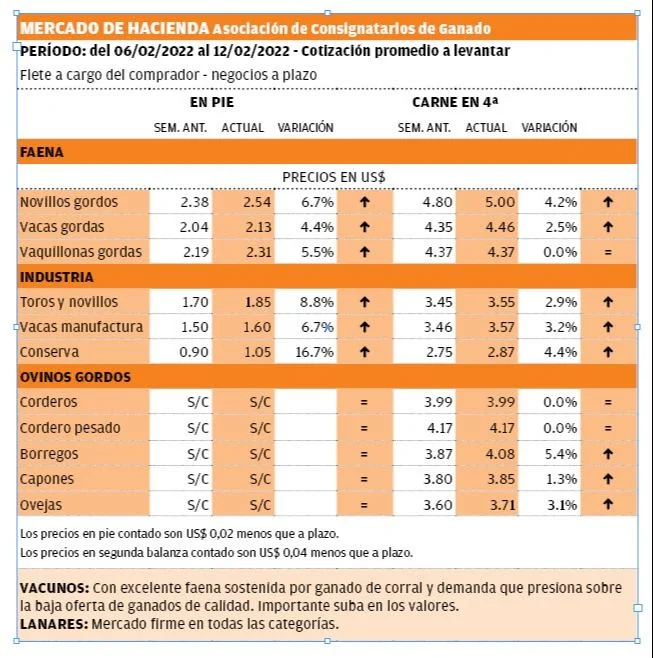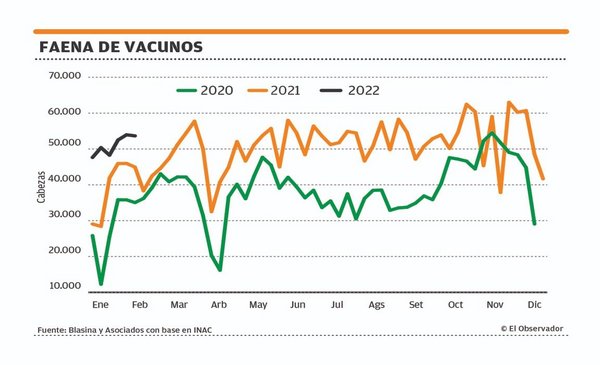A year ago US$ 4 was something far away. In mid-February 2021, the best steers were trading on the axis of US$3.50 per kilo on the fourth scale. Today, with a dollar and a half more, they reach US$ 5. And although this value is achieved in exceptional businesses –for voluminous lots of special cattle–, firmness persists.
The cattle of good finish and quality continue to appear in drops. Most bargains settle for between $4.80 and $4.90.
The gap has widened with the fat cow, which for peak batches is sold between US$4.60 and US$4.65 per kilo, compared to US$3.27 a year ago.
In all cases, the entrances to the plants are kept short, about seven days.
With record prices for cattle for slaughter, a little more supply appears, although not enough to cool a market on fire.
Industrial demand is one of the keys in this bullish combo. Last week, 53,653 cattle were slaughtered, with the participation of free-range cattle with quota and non-quota slaughter.
In the first six weeks of the year, the activity of last year at this point is already almost 50,000 heads higher, with 305,722 compared to 256,206, a year-on-year jump of 19%.
The trend has been accentuated since the beginning of the year: much more early steers and less than adult steers.
john samuel
Livestock production, in the midst of a very good moment.
This strong dynamic of the refrigerators is supported by Chinawhich continues to buy at full speed posaño nuevo lunar and at good prices.
Europe recovering from the latest wave of covid and prices for beef are toned down, with references from Hilton around US$14,000 for Uruguay.
At once, the US market remains firm.
The export price shows it. Last week the average was US$ 5,149 per ton for beef, according to preliminary data from the National Meat Institute (INAC). So far in 2022, the average stands at US$4,846, a year-on-year jump of 31%.
This solid external scenario, and the optimism that came from the rains in mid-January, give consistency to the market and generate a productive impulse.
It is seen in the price jump of the replacement. And also in forward investments, for example in pastures.
In cattle for the field, the demand is firm and the offer begins to appear hand in hand with good values. Virtually all categories show raises. Calves average about US$2.57 per kilo, according to the reference price sheet prepared by the Association of Livestock Consignees (ACG).
In sheep, the market is also on an upward path. The offer has decreased after the peak at the end of the year and there is beginning to be a recovery in prices, with an industrial demand that absorbs all categories.
Lamb is priced at US$4.12 per kilo, lamb US$4.08, capon US$3.85 and sheep US$3.71 per kilo.
Contrary to what happens in cattle, sheep slaughter is below last year. 159,076 sheep have gone to the plant against 175,578 in the same period of 2021. The slaughter of lambs falls and the proportion of sheep increases.
There is a slackening in external demand and it is reflected in the volume of meat exported: 1,976 tons until February 12 against 3,078 at the same time in 2021, a retraction of 36%.
There is also a slight decrease in the export price, which last week was US$4,732, below the US$5,274 of the previous week, which was adjusted by the INAC.
Although slightly weaker, the Average Income from Exports for sheep meat remains at a high level, averaging US$5,446 in 2022, an improvement of 13.5% compared to 2021.

EO
The numbers
62.44% of foreign exchange earnings so far this year – all meats – is explained by business with China, for US$ 212.5 million. They are followed by: USMCA (Canada, United States, Mexico) with 12.14% (US$41.3 million) and the European Union with 8.65% (US$29.4 million).
47.47% of cattle slaughter so far this year it corresponds to the steers category, with 145,111 heads; 37.35% is from the cow category, with 114,182 heads; and 13.46% is from the heifer category, with 41,159 heads, based on INAC data as of February 12.







